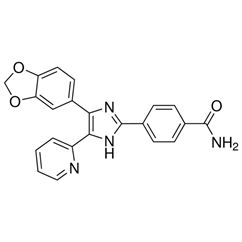Recombinant Human FGF-1 (Animal-Free)
Induced proliferation of BALB/c 3T3 cells assay for Human FGF-1 (Animal-Free). Cell proliferation was measured to calculate the ED50, which is as expected less than 2 ng/ml.

Non-reducing (-) and reducing (+) conditions in a 4 - 20% Tris-Glycine gel stained with Coomassie Blue. 1 μg of protein was loaded in each lane. Human FGF-1 has a predicted Mw of 16 kDa.
Achieve Purchasing Synergy
Request a quote at [email protected] for 2 or more vials of any Growth Factor to receive a discount. Discounts range from 5 to 20% according to the size of your order.
PODS® Growth Factors
This growth factor is also available as PODS® for sustained release, see here.Animal-Free
This product is produced with no animal derived raw products. All processing and handling employs animal free equipment and animal free protocols.Description
Fibroblast Growth Factor 1 (FGF-1) is a potent inducer of DNA synthesis, cell proliferation, and has chemotactic activities. FGF-1 regulates cardiogenesis through protein kinase C signaling. FGF-1 also functions as an insulin sensitizer and mediates adipose tissue remodeling. Other homologous FGF belonging to the same family are FGF-3, FGF-5, FGF-6, K-FGF and FGF-7.Activity Assay
Human FGF-1 is fully biologically active when compared to standard. The activity is determined by the proliferation of BALB/c 3T3 cells and it is typically less than 2 ng/ml. This corresponds to an expected specific activity of 5.0 x 105 units/mg.AA Sequence
MFNLPPGNYK KPKLLYCSNG GHFLRILPDG TVDGTRDRSD QHIQLQLSAE SVGEVYIKST ETGQYLAMDT DGLLYGSQTP NEECLFLERL EENHYNTYIS KKHAEKNWFV GLKKNGSCKR GPRTHYGQKA ILFLPLPVSS DAlternative Names
Fibroblast Growth Factor 1, acidic Fibroblast Growth Factor, FGF1, HBGF-1, β-endothelial growth factor, ECGF, endothelial cell growth factor-β, ECGF-β, GLIO703, FGFA, ECGFA, HBGF, heparin-binding growth factor 1, AFGF, endothelial cell growth factor-α, ECGFB, FGF-α, aFGF| Product Details | |
|---|---|
| Length | 141 aa |
| Molecular Weight | 16 kDa |
| Structure | Monomer |
| Source | E. coli |
| Accession Number | P05230 |
| Purity | ≥95% determined by reducing and non-reducing SDS-PAGE |
| Endotoxin Level | ≤1.00 EU/μg as measured by kinetic LAL |
| Formulation | Lyophilized from a sterile (0.2 micron) filtered aqueous solution containing 10 mM sodium phosphate, 150 mM sodium sulfate, pH 7.5 |
| Reconstitution | Centrifuge vial before opening. When reconstituting the product, gently pipet and wash down the sides of the vial to ensure full recovery of the protein into solution. It is recommended to reconstitute the lyophilized product with sterile water at 0.1 mg/ml, which can be further diluted into other aqueous solutions. If a precipitate is observed, centrifuge the solution thoroughly and use only the soluble fraction (removing it from the precipitate). A 10% overfill has been added to compensate for any loss of protein in the precipitate. |
| Stability and Storage |
12 months from date of receipt when stored at -20°C to -80°C as supplied. 1 month when stored at 4°C after reconstituting as directed. 3 months when stored at -20°C to -80°C after reconstituting as directed. |






